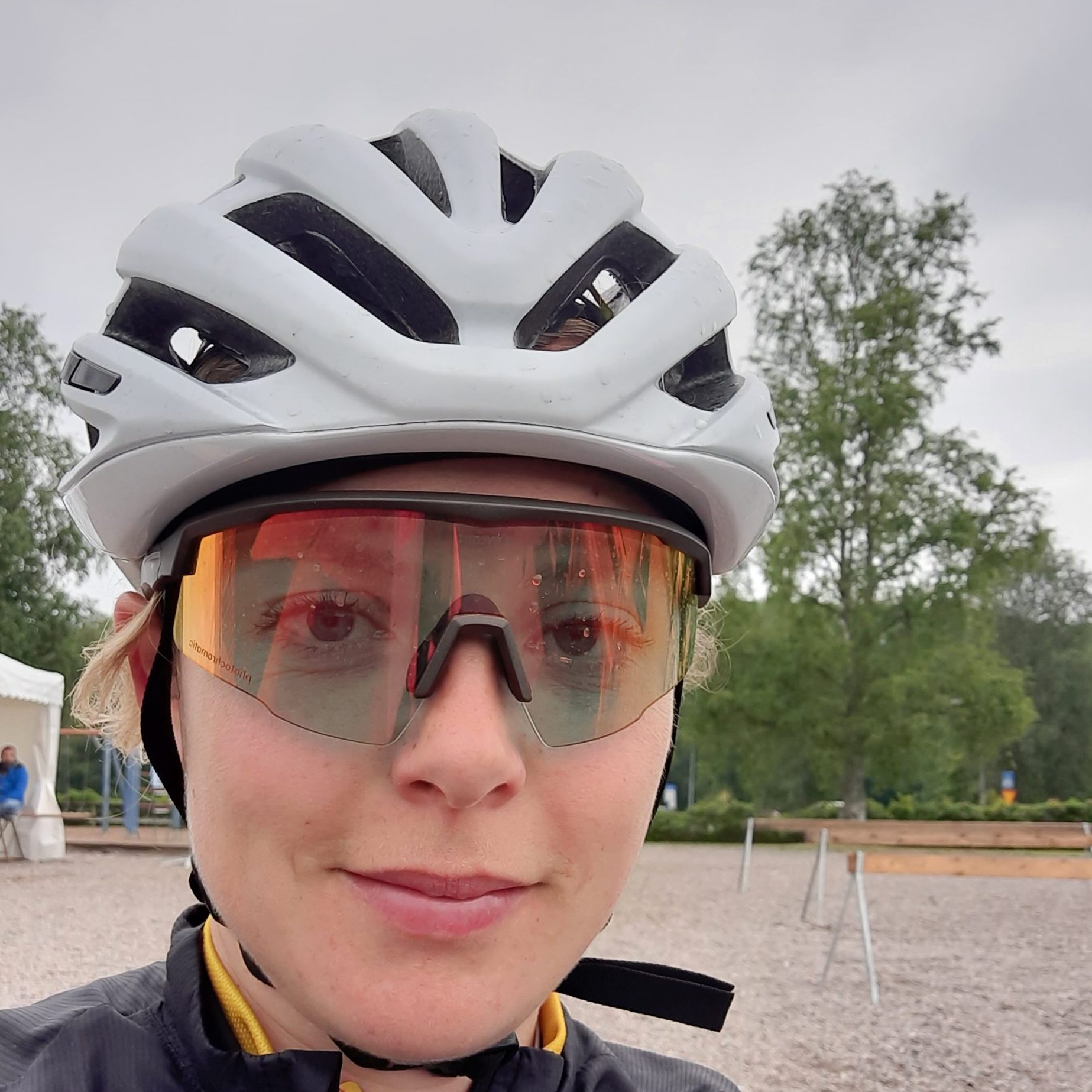This year, the Tour de France Femmes avec Zwift starts from Rotterdam in the Netherlands. The cycle-mad team from the Geological Survey of the Netherlands couldn’t resist the opportunity to explore the geothermal energy technology en route. See it as a warming up.
The top women’s cycling teams will start with the Rotterdam skyline reflecting in the futurist Boijmans Van Beuningen Depot. After a tour of the Rotterdam city center, the peloton continues towards Voorne-Putten, through the Westland and finishes on the beach of The Hague. With my colleague Victor, I cycled the route, so follow along for some fantastic uses of geology.
Let’s ride
On a dry day Victor and I checked out the course of stage one. We take in the industrial views as we cycle past the port of Rotterdam, then continue through the flat polder landscape of Voorne-Putten. As we enter the Westland, the area surrounding The Hague, the traditional windmills are replaced by vast greenhouses. We don’t leave the signs of green energy on the polder though. Several of the glass walls have banners advertising that the greenhouses use geothermal energy.
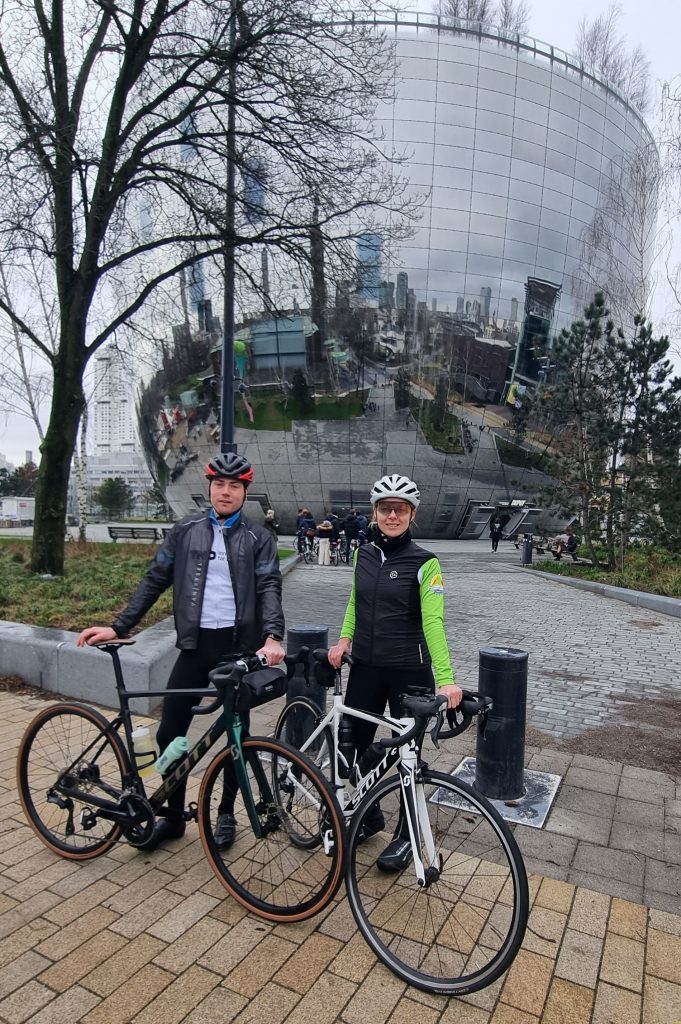
The greenhouse energy transition began in 2008 when the first geothermal energy system replaced the traditional gas-fired greenhouse heating systems in the Netherlands. Since then, more and more greenhouses use geothermal energy. What is it, how does it work and how does it contribute to the broader energy transition?
Geothermal energy
Heat is energy, and geothermal energy is heat in the underground. Although we don’t have volcanoes like in Iceland, the underground temperature still increases by 31 °C per kilometre depth on average in the Netherlands. It’s warming up. At a depth of two kilometres it is a steamy 72 °C. Geothermal energy is extracted by pumping hot water from the subsurface through a production well. This hot, salty water is located in porous rocks, such as sandstone, called reservoirs.
During our bike ride, we visit the geothermal plant of Aardwarmte Vogelaer. Victor and I are eager to see what happens to the pumped water.
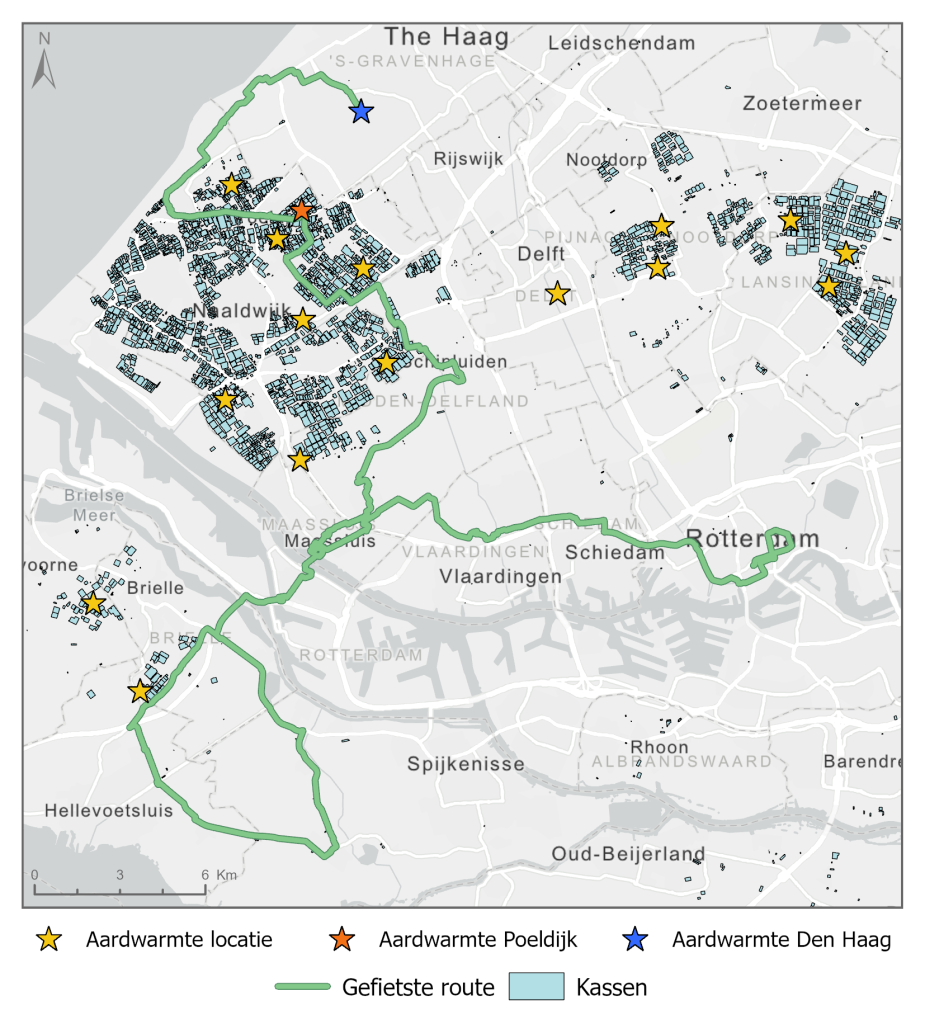
The geothermal system
When we arrive, the geothermal wells immediately catch our eye, but they would be easy to miss among on the giant greenhouse site. The only sign of the pumped hot water is the two wells, protruding from a fenced off part of the carpark, and from the wells two pipelines entering a building. Danny van den Berg, general manager and former TNO intern, welcomes us warmly and shows us around.
The company pumps hot salty water from a depth of two and a half kilometres up through the production well to the surface. They then transport the water to the building full of shiny pipes and a heat exchanger. The heat exchanger extracts heat from the pumped salt water and transfers it to fresh water. This hot, fresh water is piped to the greenhouses of 18 different companies growing everything from tomatoes to flamingo plants.
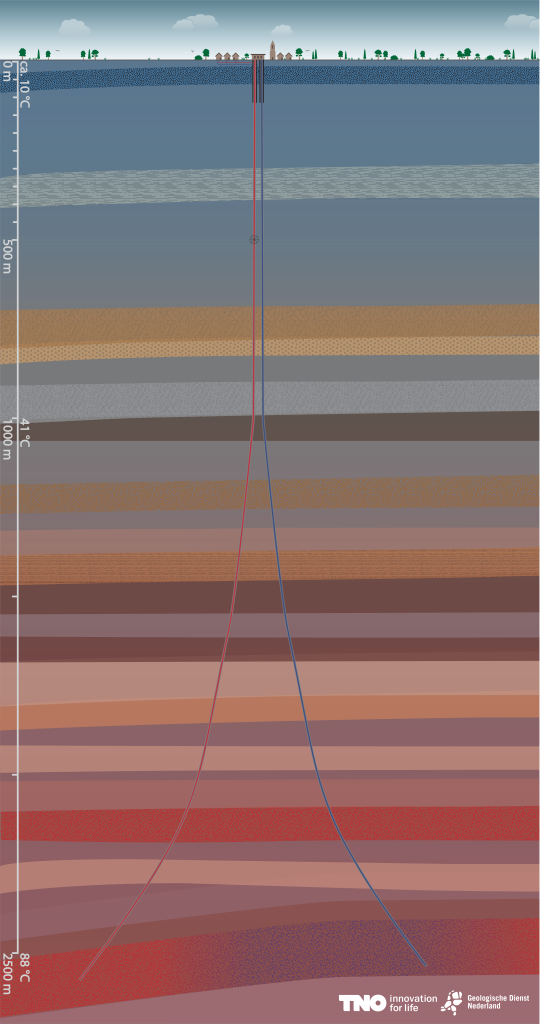
The hot water pumping process is completely circular. After handing over its heat at the exchanger, the cooled salt water is injected back into the reservoir from which it came. It goes down through a second well, called an injection well. The cold water doesn’t go back to exactly the same place though. The wells are drilled at an angle. They both pop out of the car park at the same place but at reservoir depth, 2.5 kilometers down, they’re actually about 2 kilometers apart.
Sustainable or renewable energy?
Sustainable energy is a source of energy that we can use without causing climate change or leaving pollution behind for future generations. These energy sources can be used up. This is different to renewable energy like wind or biomass where there will always be more.
The reason that the bottom of the two wells are 2 kilometres apart is that geothermal energy in the Netherlands is sustainable rather than renewable. The cold water has to be pumped back into the reservoir to maintain the pressure of the system, just like in the central heating in your house. The cold water cools the reservoir rocks and gradually flows towards the production well. When it reaches the production well, there will be no more hot water to pump and this geothermal doublet system will have reached the end of its life.
Generally, we assume a geothermal doublet system has a life span of 35 years, but it can be longer. The lifespan is mainly controlled by the rate of production. Faster extraction of geothermal energy causes faster spreading of the cold water plume to the production well.
Don’t worry though, over long time-scales, geothermal energy is actually renewable. The inside of the Earth is very, very hot and this heat slowly makes its way to the surface. After a few hundred years, the injected water and rocks will have reheated to their original temperature.
Why here in the Westland?
The Westland is a corner of land between river and sea, and almost completely covered by glass. The greenhouses started to appear in the nineteenth century. The simple windows that workers laid over their crops are a world away from the high-tech geothermally heated greenhouses of today. Those nineteenth century farmers knew their geology: the mix of clay, peat and sand creates fertile horticultural land. Coupled with the mild coastal climate and shipping connections, the fact that the Westland has the highest concentration of greenhouse horticulture in the world makes perfect sense.
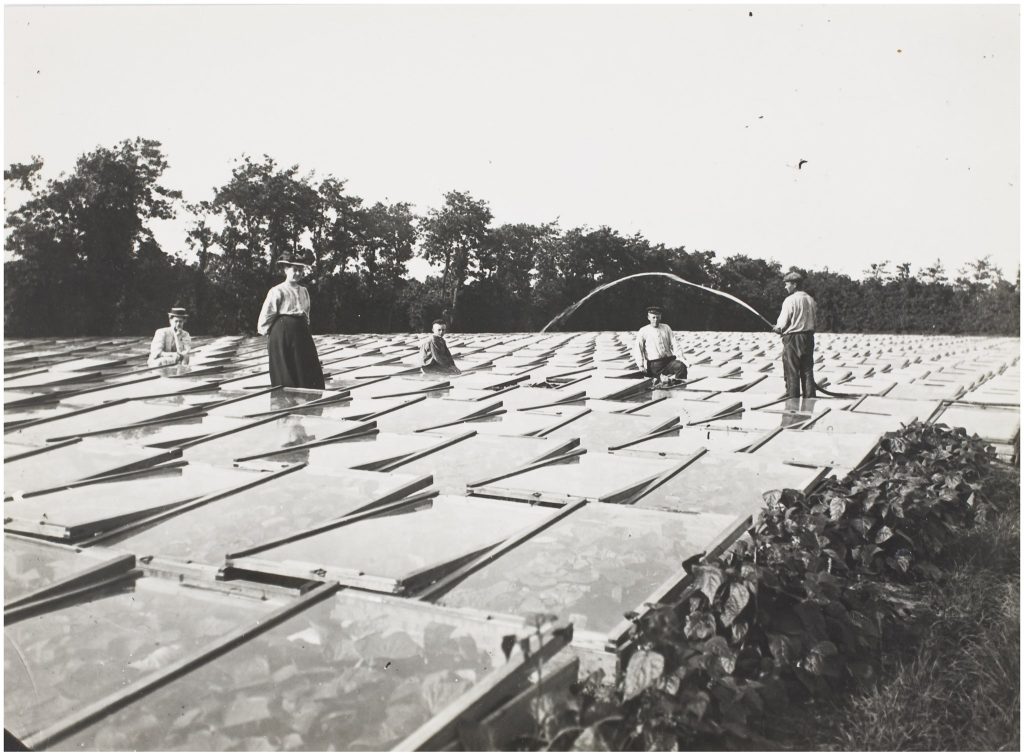
Despite the mild climate, the plants need constant temperatures and warmth. The greenhouses were originally heated with coal stoves. Today most greenhouses are using natural gas. The national bureau of statistics CBS shows that greenhouse horticulture consumed 2.05 billion cubic meters of gas in 2023. This is over 8% of the total gas consumption in the Netherlands. Replacing the natural gas by a sustainable energy source, like geothermal energy, will really help us reduce our national CO2emissions.
The future is geothermal
We’re already making a good start on the transition from natural gas. In 2023, almost 10% of greenhouses use geothermal energy. Twenty geothermal doublets were in production in 2023, together supplying about 7 PJ of heat to Dutch greenhouse horticulture. Aardwarmte Vogelaer currently has one producing doublet that provides heat to 18 companies with a total of 88 acres of greenhouses. They are currently planning a second doublet to increase capacity.
Geothermal energy is not only for greenhouses. Residential homes and offices can be heated in exactly the same way, with significant reduction in carbon emissions. Figures for 2023 show that 30% of gas consumption in the Netherlands is used for buildings. Replacing most of this with geothermal energy will help us achieve the goal of having a climate neutral society.
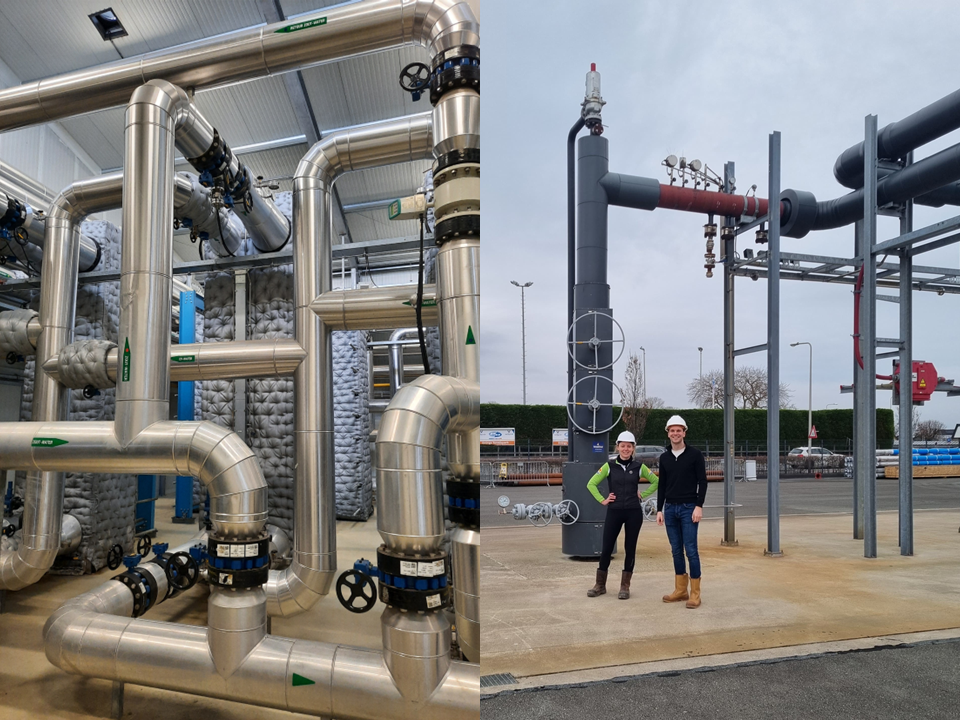
We finish our ride in The Hague, just like the riders of the Tour de Femmes will. The Hague was the first city to have a residential area heated by a geothermal system. This project is Haagse Aardwarmte Leyweg. For our riders they need to keep their heads cool on stage 1 but it will probably be a heated sprint for the win.



